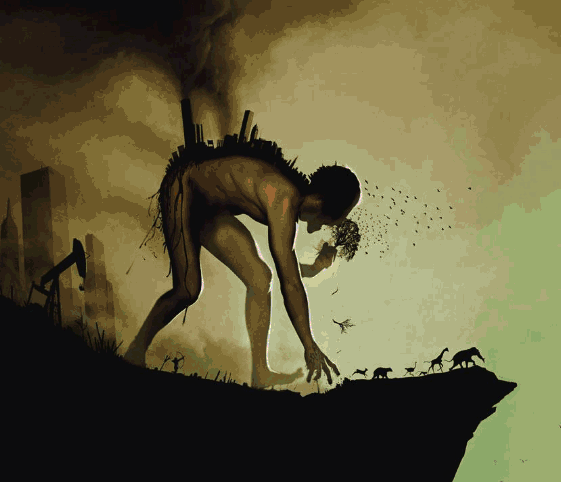 Cold with some drizzle this mid-morning Friday on California’s north coast; we await another rain-system to plow through the region starting this afternoon — a bit of sunshine earlier, but now it’s dark and gloomy, narrative-normal for an approaching storm.
Cold with some drizzle this mid-morning Friday on California’s north coast; we await another rain-system to plow through the region starting this afternoon — a bit of sunshine earlier, but now it’s dark and gloomy, narrative-normal for an approaching storm.
And cold, too — according to WunderBlog‘s weather thingy (measuring-device supposedly just a block-or-two from my apartment), the temperature is 38-degrees, an easy indication with frost still on rooftops.
In the overly-vast scheme of things, I for one am really-wanting this winter to finish, but…
(Illustration found here).
Weather is indeed in the eye of the beholder. It’s become sort of like the restaurant success/failure ratio being based on three things: Location, location, location.
While we’re cold and wet up here in northern California, from the Bay Area-south, the weather is warm and wet. We’ve returned to the northerly storm cycle, while SoCal still rocks from all those ‘atmospheric rivers‘ originating from the south Pacific. These storms are record-breakers — Anaheim received 21.25 inches through Monday, 238 percent of normal, and San Diego is 141 percent above average, a good drought punch.
And even more weird, location-wise, the interior US is currently in a freaky heatwave.
Climate change alters venue, the perspective.
Via Climate Central yesterday:
There have been 3,146 record highs set for the month-to-date compared to only 27 record lows, ensuring February will go down as the 27th month in a row with more highs than lows.
The astonishing 116-to-1 ratio of highs to lows would easily set a record for the most lopsided monthly ratio in history.
There have also been 248 monthly record highs and no monthly record lows.
“If the eventual ratio is above 50-to-1 this would be historic,” Guy Walton, a meteorologist who tracks record temperatures, said.
The increasing ratio of record highs vs. record lows is one of the hallmarks of climate change.
By raising the baseline temperature, climate change has made it more likely for record highs to be set while decreasing the odds of record lows.
In a world that wasn’t warming, that ratio would remain constant right around 1-to-1, but research has shown that hasn’t been the case with highs outpacing lows more and more with each passing decade.
…
The winter warmth in the Southeast is directly linked with the storms rolling through California.
“This year the circulations and storm tracks that are cruising straight across the Pacific to Northern California are part of a pattern that is also shielding the Southeast from the kinds of cold air intrusions from higher latitudes that it gets in a more normal winter,” Scripps Institution of Oceanography climate researcher Michael Dettinger said while noting it’s a marked shift compared to the winters of 2014 and 2015.
Across the US, heat and heat — from HuffPost this morning:
A bonkers February with stretches of extremely high temperatures mixed periodically with plunging mercury is the latest chilling warning about global warming.
Single-day record highs as well as multiple-day heat waves broke more than 248 month-to-date records for February in spots across the nation, according to the National Center for Environmental Information.
Temperatures in Oklahoma, the home state of new Environmental Protection Agency chief Scott Pruitt, a climate change skeptic, nearly reached triple digits earlier this month.
The town of Mangum hit an all-time record Feb. 11 of 99 degrees, more than 40 degrees above the average February high.
The rest of the Southern Plains also broke records, and the Texas towns of Midland, Lubbock and Wichita Falls all racked up temperatures in the 90s the same week.
A cold snap followed the heat wave in the region, with temperatures dropping as much as 50 degrees.
Milwaukee’s 71 degrees this Wednesday was the highest temperature ever recorded in the state in the winter.
(The typical high temperature for the day is 34.5 degrees).
It was also the fourth time in February the city hit temperatures over 60 degrees, another all-time record for the state, the Milwaukee Journal Sentinel reported.
Boston hit 68 degrees Thursday, busting its previous highest temperature of 65 degrees in 1990.
All-time record highs for the month of February were broken Thursday in Burlington (63 degrees) and Montpelier, Vermont (63 degrees).
Denver broke its third record of the month last Thursday, topping out at 75 degrees, a full 5 degrees hotter than the date’s previous record, according to the National Weather Service. Snow was back a week later Friday.
Meanwhile back on the North Coast, right now there’s some occasional flare of sunshine — can’t the weather make up its mind?